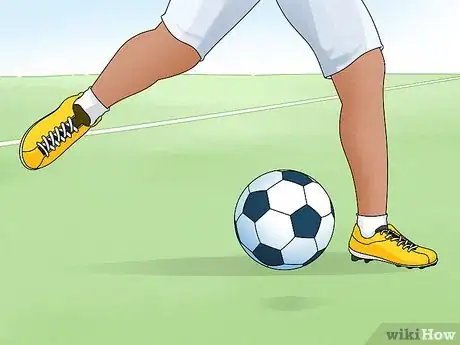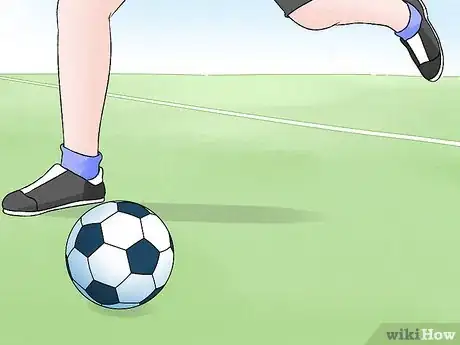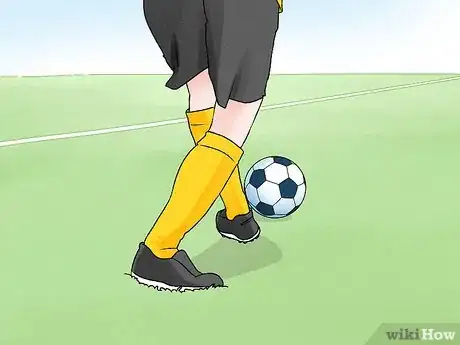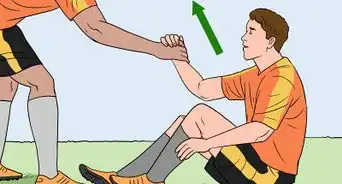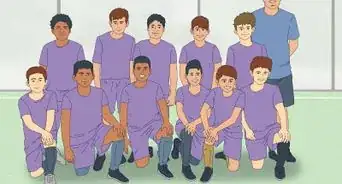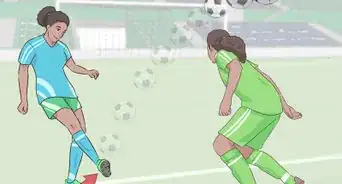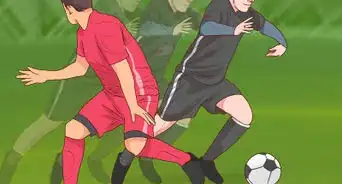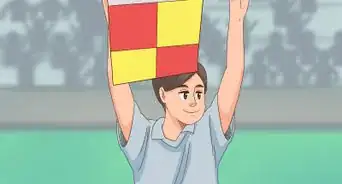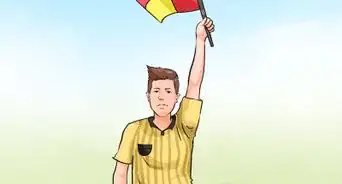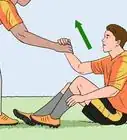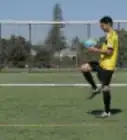This article was co-authored by Bernat Franquesa. Bernat Franquesa is the Co-Founder and Head of Methodology at APFC (Albert Puig Football Concepts), a youth development program for players and coaches with headquarters in San Diego, California. APFC provides soccer training for youth and educational content and consulting services for coaches, academies, and clubs. At APFC, Bernat is responsible for co-developing and applying technical guidelines for player development programs. He has been coaching soccer in Catalunya and the US since he was 15 years old.
There are 9 references cited in this article, which can be found at the bottom of the page.
wikiHow marks an article as reader-approved once it receives enough positive feedback. In this case, 85% of readers who voted found the article helpful, earning it our reader-approved status.
This article has been viewed 261,486 times.
Passing the ball is one of the main skills in soccer.[1] There are a few different types of passes that can help get you out of tricky situations. Grab a friend and start by learning the push pass. Then you can work your way up to the harder moves like the lofted, chipped, and one-two passes.
Steps
Learning the Push Pass
-
1Use a push pass for a short, direct pass. The push pass is the easiest one to kick, so start by learning this one. The push pass is also the easiest to intercept. Make sure that your teammate doesn’t have someone hovering nearby ready to steal the ball.[2]
- The push pass is also known as the direct pass or the forward pass.
-
2Place your plant foot even with the ball. Position your plant foot so it faces your target. The plant foot is the one that will not be kicking and helps keep you steady. Eventually you can practice kicking with each foot to become a balanced player, but for the first time, use whichever foot you are more comfortable with.[3]Advertisement
-
3Keep your kicking ankle firm and your body over the ball. Keep your ankle firm, not floppy, during the kicking and follow-through to protect yourself from injury. Hold the toes of your kicking foot slightly higher than the heels. Position your body so it's facing the person you are kicking toward.[4]
- It may help to imagine a line going from your belly button to your target.
-
4Kick using the inside of your foot. Don’t kick using the laces, heel, or outside of the foot when you are first learning. Kick at right angles to the ball at the midline of the ball. Kicking at the middle of the ball helps keep it on the ground.[5]
- It can be hard to stay balanced when you are standing on one foot, so try putting your arms out.
Kicking a Lofted Pass
-
1Use a lofted pass if you need to get the ball over your opponents’ heads. If your opponents are closing in on you, and there is no one you can directly pass the ball to, the lofted pass is a great move. It’s more advanced than the push pass, but with practice, you can nail it.
-
2Put your plant foot out wide and approach at a 15-degree angle. Like a push pass, point your plant foot in the direction of the kick, but place it about 6 inches (15 cm) behind and 9 inches (23 cm) outside of the ball. [6]
-
3Kick the bottom of the ball with the front of your foot. Use the front of your foot at about the area where the knuckle of your big toe is. Raise your foot behind you and keep your body leaned back as you kick the ball. When you make contact with the ball, keep your ankle firm on the bottom half of the ball. This will scoop the ball up and into the air.[7]
- Start by practicing at a low speed, and work your way up to faster lofted passes.[8]
Mastering the Chip Pass
-
1Use the chip pass if you have many defenders around you and your teammate is close. The chipped pass will go a short distance, but it will fly through the air like a lofted pass. It has more backspin than a lofted pass, so it’s going to stay in the air longer.[9]
- Make sure you practice chipping on grass because your foot might ram into the ground.
-
2Run up to the ball at about 45 degrees and plant your foot. Put your plant foot about 6 inches (15 cm) behind and 9 inches (23 cm) outside of the ball. Point your kicking foot away from you. Raise your backswing by lifting your foot behind you. The shorter the backswing, the more control you will have over the ball.
-
3Kick the ball as low as possible with your instep. Use your foot to form a wedge that slides under the ball. Kick with a stabbing motion to send the ball flying up in the air. Try to use enough backspin to keep it from going too far. Lean back as you kick and follow through slightly to make the ball go higher. Don’t lean too far though––you don’t want to fall![10]
- Another form of chipping involves kicking with your toes.
Passing the One-Two
-
1Choose the one-two if you need to get around a single defender. For example, if you are approaching the goal and there is one last defender right in your way, you can use the one-two to send the ball in a triangle around your opponent.[11]
-
2Push pass the ball to your teammate. Use the inside of your foot to pass the ball directly toward your teammate’s feet. If you don’t know how to do the push pass, learn that one first, because the one-two is a more complex move.
-
3Sprint past your opponent immediately after you kick. Make sure to end up in an open space, because your teammate will pass the ball right back to you. This kind of pass is also called a wall pass because it’s similar to bouncing the ball off a wall.[12]
- Create a signal you can use with your teammate to indicate that you are attempting the one-two pass.
-
4Receive the ball and pass again or dribble. You’ll have to act quickly to receive the ball as your teammate passes it back. This move requires a lot of practice, so don’t worry if you don’t get it the first couple of times![13] Now that you have the ball again and are further up the field, determine whether it's best to dribble, pass, or try to score.
Expert Q&A
Did you know you can get expert answers for this article?
Unlock expert answers by supporting wikiHow
-
QuestionHow can I become a better soccer player?
 Bernat FranquesaBernat Franquesa is the Co-Founder and Head of Methodology at APFC (Albert Puig Football Concepts), a youth development program for players and coaches with headquarters in San Diego, California. APFC provides soccer training for youth and educational content and consulting services for coaches, academies, and clubs. At APFC, Bernat is responsible for co-developing and applying technical guidelines for player development programs. He has been coaching soccer in Catalunya and the US since he was 15 years old.
Bernat FranquesaBernat Franquesa is the Co-Founder and Head of Methodology at APFC (Albert Puig Football Concepts), a youth development program for players and coaches with headquarters in San Diego, California. APFC provides soccer training for youth and educational content and consulting services for coaches, academies, and clubs. At APFC, Bernat is responsible for co-developing and applying technical guidelines for player development programs. He has been coaching soccer in Catalunya and the US since he was 15 years old.
Licensed Soccer Coach
-
QuestionWhat is the procedure when passing?
 Community AnswerBefore receiving the ball, always know where your teammates are, and try to keep your head up. Do not try to do long balls or cross-field balls in the starting. Start with simple, short passes, and go from there. Pass with the correct part of your feet.
Community AnswerBefore receiving the ball, always know where your teammates are, and try to keep your head up. Do not try to do long balls or cross-field balls in the starting. Start with simple, short passes, and go from there. Pass with the correct part of your feet. -
QuestionWhat is the best way to defend a pass?
 Community AnswerYou can't be afraid. Your opponent will see it and use it against you. Don't stand still; keep moving and pass when you can.
Community AnswerYou can't be afraid. Your opponent will see it and use it against you. Don't stand still; keep moving and pass when you can.
Warnings
- Make sure that you don't kick with your toes, because you might hurt yourself.⧼thumbs_response⧽
Things You'll Need
- Soccer ball
- Soccer cleats
- Shinguards
- Someone to practice with
References
- ↑ Bernat Franquesa. Licensed Soccer Coach & Head of Methodology at APFC. Expert Interview. 3 March 2020.
- ↑ http://www.ucs.mun.ca/~dgraham/manual/Pages/Basics/push_demo.html
- ↑ https://www.stack.com/a/how-to-teach-youth-soccer-players-basic-passing-skills
- ↑ https://www.soccercoachweekly.net/soccer-drills-and-skills/how-to-coach-perfect-passing-technique/
- ↑ https://www.soccercoachweekly.net/soccer-drills-and-skills/how-to-coach-perfect-passing-technique//
- ↑ https://coachingamericansoccer.com/intermediate-soccer-skills/intermediate-passing-the-lofted-drive/
- ↑ https://www.completesoccerguide.com/soccer-passing/
- ↑ https://www.stack.com/a/how-to-teach-youth-soccer-players-basic-passing-skills
- ↑ https://www.completesoccerguide.com/soccer-passing/
- ↑ https://www.completesoccerguide.com/soccer-passing/
- ↑ https://coachingamericansoccer.com/intermediate-soccer-skills/intermediate-passing-the-give-and-go/
- ↑ https://www.ducksters.com/sports/soccer/passing_the_ball.php
- ↑ Bernat Franquesa. Licensed Soccer Coach & Head of Methodology at APFC. Expert Interview. 3 March 2020.
About This Article
Learning to pass the ball in soccer will take your game to the next level and help your team score goals. To pass to a nearby teammate, just plant your non-dominant foot beside the ball and kick it with the inside of your dominant foot. If you need to get past a defender, pass to another player diagonally ahead of you, sprint past the defender, and call for the ball back. This is often called a 1-2 pass. If you need to get the ball over a defender’s head to your teammate, kick the bottom of ball with the front of your foot. Try to kick with the knuckles of your toes instead of your toes, since you can easily hurt yourself that way. For more tips, including how to do a chip pass, read on!



